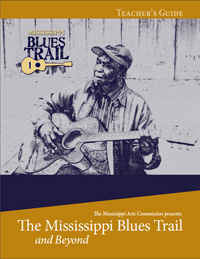The state’s history as seen through the words and images of bluesmen and women is part of the curriculum launched by the Mississippi Arts Commission (MAC).
The 18-lesson Mississippi Blues Trail Curriculum features an interactive, multimedia resource page and is available free at http://msbluestrail.org/curriculum. Project director Mary Margaret White (MA Southern Studies ’07) credits her connection to the Mississippi Blues Commission, the governing body of the Mississippi Blues Trail, as the inspiration for the curriculum.
“When folks come to Mississippi, they want an authentic experience. That’s where the Blues Trail comes in,” said White, MAC folk and traditional arts director. “While the markers tell the stories of these great musicians—how they lived and how their music continues to influence music today—I was painfully aware that many young Mississippians knew little about our blues history.”
After securing a $25,000 grant from the National Endowment for the Arts, White found a dream team to pull the project together. Mark Malone, curriculum designer at William Carey University in Hattiesburg, and Scott Barretta, who teaches anthropology of the blues at UM, joined White for the project. Barretta, host of the Highway 61 Radio Show produced at UM by the Southern Documentary Project for Mississippi Public Broadcasting, works as writer and researcher (along with Jim O’Neal) for the Mississippi Blues Trail.
“Scott was my first choice,” White said. “He’s a widely published music journalist, former editor of Living Blues magazine and a renowned blues historian. Dr. Malone is well-known as a curriculum designer and was able to take this history and put it together in the language teachers need.”
The team’s goal was to draw upon the history already provided on the state’s hundreds of Blues Trail markers. “Each marker is thoroughly researched and we have a wonderful website with a wealth of information,” Barretta said. “Teachers are encouraged to go there to find details about the lives and music of blues legends such as Robert Johnson, and then draw upon that information to illustrate the broader cultural issues in the curriculum.”
White agreed. “It’s not just a bunch of biographies; we used the blues to broaden the understanding of social studies concepts, including civil rights, geography, media and much more.”
The curriculum’s 18 lessons are spread across six core areas: music, meaning, cotton, transportation, Civil Rights and media. Although designed for fourth-graders studying Mississippi history, teachers may modify the lessons to accommodate students through 12th grade.
Each lesson is aligned with established state and national standards, which help teachers share the skills needed for high student performance on standardized tests. These standards include the Mississippi Studies Framework for social studies and music, the National Standards for Music Education, and the Common Core Standards for writing, language, speaking and listening.
